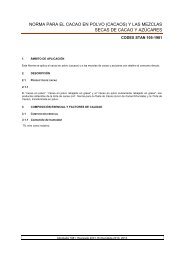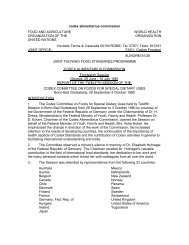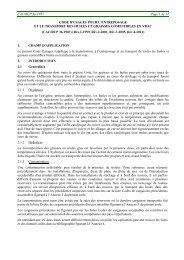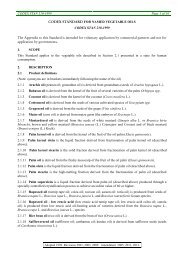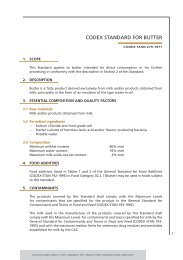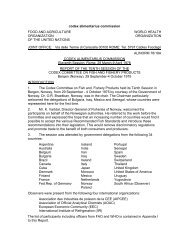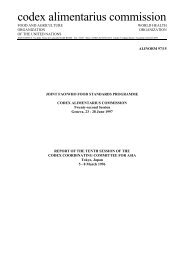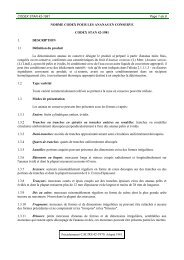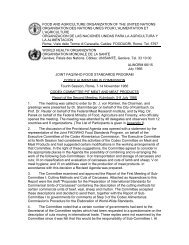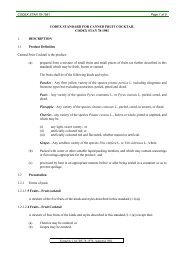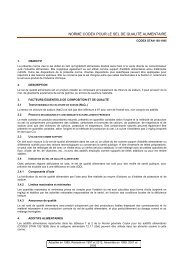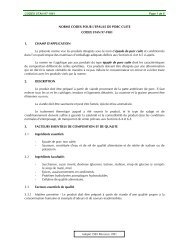REP13/FH JOINT FAO/WHO FOOD STANDARDS PROGRAMME ...
REP13/FH JOINT FAO/WHO FOOD STANDARDS PROGRAMME ...
REP13/FH JOINT FAO/WHO FOOD STANDARDS PROGRAMME ...
You also want an ePaper? Increase the reach of your titles
YUMPU automatically turns print PDFs into web optimized ePapers that Google loves.
<strong>REP13</strong>/<strong>FH</strong> Appendix II 41<br />
(g) be provided with sufficient and adequate electrical power supply to support the vendors in the centre to<br />
operate appliances, equipment and other implements used in the preparation, handling, storage,<br />
serving and selling of food; and<br />
(h) have available an ample supply of potable water, under adequate pressure and of suitable<br />
temperature, with adequate facilities for its storage, where necessary, and distribution, and with<br />
adequate protection against contamination.<br />
NOTE: Samples should be taken regularly, but the frequency should depend upon the origin and the usage of<br />
the water, e.g. more frequent from private supplies that from public supplies. Chlorine or other suitable<br />
disinfectants may be used. If chlorination has been employed checks should be made daily by chemical tests for<br />
available chlorine. The point of sampling should preferably be at the point of usage, but occasionally it would be<br />
useful to sample at the point of entry of the water to the establishment.<br />
8.2.3 Street food centres shall be properly constructed in a manner using materials approved by the relevant<br />
authority, taking into consideration the provisions stated in the paragraph on “Structure, of these Guidelines. In<br />
addition to these provisions, street food centres should:<br />
(a) have smooth cement, glazed tile or tarmac paved floors, equipped with properly placed floor drains<br />
for the purpose of removing surface water and to facilitate cleaning and sanitizing;<br />
(b) have, where applicable, smooth non-permeable surface walls or partitions, such as glazed tile, to<br />
facilitate cleaning and sanitizing;<br />
(c) have, if applicable, a smooth non-absorbent ceiling to facilitate cleaning;<br />
(d) provide sufficient artificial lighting, properly placed to facilitate food preparation, handling, storage,<br />
serving and selling for each vendor located at the centre;<br />
(e) provide for smoke hoods and flues above cooking ranges to enable the removal of fuel and cooking<br />
gases, smoke and fumes from the centre into the open air.<br />
(f) provide centralized or individualized appliance, crockery, utensil and other implement washing<br />
facilities, equipped with hot and cold running potable water, wash basins or sinks with appropriate<br />
drains to an approved sewer or drain system, detergent and sanitizing agents to satisfy the proper<br />
sanitary and complete cleaning needs of the vendors in the centre; and<br />
(g) comply with any other requirement of the relevant authority related to the structure of street food<br />
centres.<br />
8.3 Liquid and solid waste<br />
8.3.1 Pertaining to liquid waste disposal, street food centres are to:<br />
(a) be equipped with an efficient centralized or individual (for each vendor in the centre) liquid waste<br />
disposal system(s) approved by the relevant authority and of suitable size and design to exceed the<br />
level of demand for liquid waste disposal at peak levels of activity by the vendors in the centre;<br />
(b) maintain the liquid sewage disposal system in good working condition;<br />
(c) ensure that the liquid waste disposal system exits to a relevant authority approved sewage drain<br />
system capable of efficiently carrying away the liquid waste from the centre; and<br />
(d) comply with any other relevant authority requirements related to liquid waste disposal.<br />
8.3.2 Regarding solid waste disposal, street food centres are to have an efficient system for disposal of solid<br />
waste complying with all solid waste disposal requirements of the relevant authority, to include:<br />
(a) the allocation of an appropriate and separate amount of space for solid waste storage, located at a<br />
convenient but suitably distant location from food preparation, storage, handling, serving or selling<br />
areas to prevent contamination;<br />
(b) sufficient number of suitably designed and constructed waterproof solid waste containers with tight<br />
fitting lids to adequately contain the volume of accumulated solid waste produced by vendor activity<br />
in one day. Containers should be lined with suitable disposable liners or inner containers for securing<br />
waste and which are easy to handle at time of disposal;



